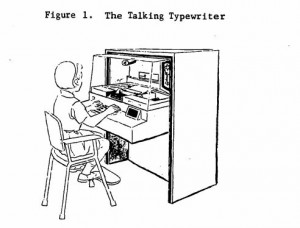Presumably on account of the narrative role of Winnipigeon Marshall McLuhan (playing throughout with his cigar), the following publicity piece for an upcoming television program appeared in the Winnipeg Tribune (p 45) on Sept 18, 1965:
Teacher with a Heart of Steel
“Programmed instruction” is a new phrase being heard more and more in the field of education. It is used interchangeably with the “teaching machine revolution” to describe experiments in which children learn reading and writing and even algebra, without teacher and textbook.
Although experiments with machines, principally the so-called “talking typewriter”, have been carried out for several years, this revolutionary method of teaching is still tentative, and educators are divided on its long-term wide-spread use.
The program entitled Child of the Future, telecast at 10 p.m. on Channel 6, reviews the United States [experience?] and includes some profound observations by Prof. Marshall McLuhan of the University of Toronto.
The “talking typewriter” — more correctly, the Edison Responsive Environment — is a large steel cabinet incorporating a typewriter with special keys that cannot jam, a window on which letters, words and sentences are shown, a slide projector, a microphone, and a speaker — all connected to a computer. (The figure below did not appear with the Tribune article. It is taken from this paper describing the development and use of the Edison Responsive Environment.)
The ERE machine can talk, play games, take dictation. and show pictures, and has been credited with teaching two and three-year-olds to read and type, and even with improving the behaviour of several children afflicted with a severe form of schizophrenia.
While many experts feel that programmed teaching is effective, critics say that such methods can stultify children’s creative thinking. And what the child learns depends on the teacher who programs the machine, therefore they are still open to human shortcomings.
But Dr. O. K. Moore, ERE’s inventor and director of the Responsive Environments Laboratory of Hamden, Conn is optimistic. “For the first time in human history,” he says, “technology allows us to have an educational scheme truly tailored to the individual person — even it we are dealing with millions of people.”
Other leading scholars and educators appearing on the program include: Prof. Jerome s Bruner, director ol the Center for Cognitive Studies, Harvard University; Bartlett Hayes, curator of the Addison Gallery of American Art, Andover, Mass; Robert Gardner, lecturer in visual Studies, Carpenter Center, Harvard University; Eleanor Duckworth staff member at the Peabody Public School, Cambridge, Mass; and Dr. H. B. McCarty, executive director of the “Wisconsin School of the Air”, University of Wisconsin.
Child of the Future was produced by the National Film Board of Canada.
